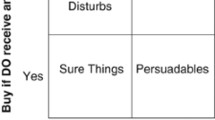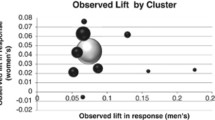Abstract
Uplift modeling, also referred to as heterogeneous treatment effect estimation, is a machine learning technique utilized in marketing for estimating the incremental impact of treatment on the response of each customer. Uplift models face a fundamental challenge in causal inference because the variable of interest (i.e., the uplift itself) remains unobservable. As a result, popular uplift models (such as meta-learners and uplift trees) do not incorporate loss functions for uplifts in their algorithms. This article addresses that gap by proposing uplift models with quasi-loss functions (UpliftQL models), which separately use four specially designed quasi-loss functions for uplift estimation in algorithms. Using simulated data, our analysis reveals that, on average, 55% (34%) of the top five models from a set of 14 are UpliftQL models for binary (continuous) outcomes. Further empirical data analysis shows that over 60% of the top-performing models are consistently UpliftQL models.
Similar content being viewed by others
References
Angrist JD, Pischke JS (2008) Mostly harmless econometrics: An empiricist’s companion. Princeton University Press
Athey S, Imbens GW (2015) Machine learning methods for estimating heterogeneous causal effects. Stat 1050(5):1–26
Austin PC (2011) An introduction to propensity score methods for reducing the effects of confounding in observational studies. Multivar Behav Res 46(3):399–424
Chawla NV (2003) C4.5 and imbalanced data sets: investigating the effect of sampling method, probabilistic estimate, and decision tree structure. In Proceedings of the ICML (Vol. 3, p. 66). CIBC, Toronto, ON, Canada
Chen H, Harinen T, Lee JY, Yung M, Zhao Z (2020) Causalml: python package for causal machine learning. ar**v preprint ar**v:2002.11631
Chickering DM, Heckerman D (2000) Targeted advertising with inventory management. In: Proceedings of the 2nd ACM Conference on Electronic Commerce, pp 145–149
Demšar J (2006) Statistical comparisons of classifiers over multiple data sets. J Mach Learn Res 7:1–30
Gubela RM, Lessmann S, Jaroszewicz S (2020) Response transformation and profit decomposition for revenue uplift modeling. Eur J Oper Res 283(2):647–661
Guelman L, Guillén M, Pérez-Marín AM (2012) Random forests for uplift modeling: an insurance customer retention case. In Modeling and Simulation in Engineering, Economics and Management: International Conference, MS 2012, New Rochelle, NY, USA, May 30-June 1 2012 Proceedings. Springer, Berlin Heidelberg, pp 123–133
Gutierrez P, Gérardy JY (2017) Causal inference and uplift modelling: a review of the literature. In: International Conference on Predictive Applications and APIs. PMLR, pp 1–13
Guyon I, Gunn S, Ben-Hur A, Dror G (2004) Result analysis of the NIPS 2003 feature selection challenge. In: Advances in neural information processing systems, p 17
Hansotia B, Rukstales B (2002) Incremental value modeling. J Interact Mark 16(3):35–46
Hirano K, Imbens GW, Ridder G, Rubin DB (2001) Combining panel data sets with attrition and refreshment samples. Econometrica 69(6):1645–1645
Hitsch, GJ, Misra, S (2018) Heterogeneous treatment effects and optimal targeting policy evaluation. Available at SSRN 3111957. https://doi.org/10.2139/ssrn.3111957
Hu J (2022) Customer feature selection from high-dimensional bank direct marketing data for uplift modeling. J Market Anal 11(2):160–171
Imbens GW, Rubin DB (2015) Causal inference in statistics, social, and biomedical sciences. Cambridge University Press
Jaskowski M, Jaroszewicz S (2012) Uplift modeling for clinical trial data. In: ICML Workshop on Clinical Data Analysis, vol 46, pp 79–95
Künzel SR, Sekhon JS, Bickel PJ, Yu B (2019) Metalearners for estimating heterogeneous treatment effects using machine learning. Proc Natl Acad Sci 116(10):4156–4165
Lo VS (2002) The true lift model: a novel data mining approach to response modeling in database marketing. ACM SIGKDD Explorations Newsl 4(2):78–86
Louizos C, Shalit U, Mooij JM, Sontag D, Zemel R, Welling M (2017) Causal effect inference with deep latent-variable models. Advances in Neural Information Processing Systems, 30
Mani I, Zhang I (2003) KNN approach to unbalanced data distributions: a case study involving information extraction. In: Proceedings of workshop on learning from imbalanced datasets, vol 126, no. 1. ICML, pp 1–7
Nassif H, Kuusisto F, Burnside ES, Shavlik JW (2013) Uplift Modeling with ROC: an SRL Case Study. In: ILP (Late Breaking Papers) pp 40–45
Nie, X, Wager, S (2017) Learning objectives for treatment effect estimation. ar**v preprint ar**v:1712.04912
Nie X, Wager S (2021) Quasi-oracle estimation of heterogeneous treatment effects. Biometrika 108(2):299–319
Radcliffe NJ (2007) Using control groups to target on predicted lift: Building and assessing uplift models. Direct Marketing Anal J 1(3):14–21
Radcliffe NJ (2008) Hillstrom’s MineThatData email analytics challenge: an approach using uplift modelling. Stochastic Solutions Ltd., Edinburgh
Rosenbaum PR, Rubin DB (1983) The central role of the propensity score in observational studies for causal effects. Biometrika 70(1):41–55
Rößler J, Schoder D (2022) Bridging the Gap: A Systematic Benchmarking of Uplift Modeling and Heterogeneous Treatment Effects Methods. J Interactive Market 57(4):629–650
Rubin DB (1974) Estimating causal effects of treatments in randomized and nonrandomized studies. J Educ Psychol 66(5):688
Rubin DB (1997) Estimating causal effects from large data sets using propensity scores. Annals of Internal Med 127(8_Part_2):757–763
Rudaś K, Jaroszewicz S (2018) Linear regression for uplift modeling. Data Min Knowl Disc 32:1275–1305
Rzepakowski P, Jaroszewicz S (2012) Decision trees for uplift modeling with single and multiple treatments. Knowl Inf Syst 32(2):303–327
Shaar A, Abdessalem T, Segard O (2016) Pessimistic uplift modeling. ar**v preprint ar**v:1603.09738
Sołtys M, Jaroszewicz S, Rzepakowski P (2015) Ensemble methods for uplift modeling. Data Min Knowl Disc 29:1531–1559
Weisberg H, Pontes V (2015) Post hoc subgroups in Clinical Trials: Anathema or Analytics. Clin Trials 12(4):357–364
Yen SJ, Lee YS (2009) Cluster-based under-sampling approaches for imbalanced data distributions. Expert Syst Appl 36(3):5718–5727
Zhang W, Li J, Liu L (2021) A unified survey of treatment effect heterogeneity modelling and uplift modelling. ACM Computing Surveys (CSUR) 54(8):1–36
Zhao Z, Harinen T (2019) Uplift modeling for multiple treatments with cost optimization. In: 2019 IEEE International Conference on Data Science and Advanced Analytics (DSAA). IEEE, pp 422–431
Author information
Authors and Affiliations
Corresponding author
Additional information
Responsible editor Johannes Fürnkranz.
Publisher's Note
Springer Nature remains neutral with regard to jurisdictional claims in published maps and institutional affiliations.
Rights and permissions
Springer Nature or its licensor (e.g. a society or other partner) holds exclusive rights to this article under a publishing agreement with the author(s) or other rightsholder(s); author self-archiving of the accepted manuscript version of this article is solely governed by the terms of such publishing agreement and applicable law.
About this article
Cite this article
Hu, J., de Haan, E. & Skiera, B. Uplift modeling with quasi-loss-functions. Data Min Knowl Disc (2024). https://doi.org/10.1007/s10618-024-01042-x
Received:
Accepted:
Published:
DOI: https://doi.org/10.1007/s10618-024-01042-x




